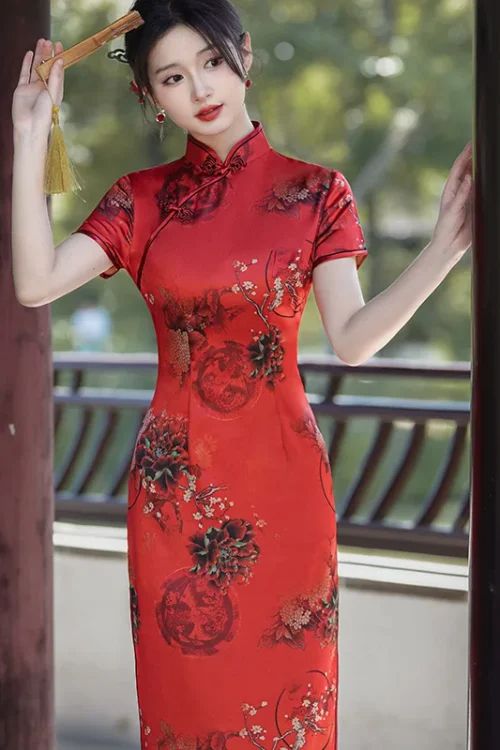The Significance of Floral Motifs in 旗袍 Design
Introduction
The qipao, a traditional Chinese dress, is renowned for its exquisite floral patterns that hold profound cultural significance. These patterns, meticulously embroidered or printed, adorn the qipao with vibrant hues and intricate designs, each motif carrying a unique meaning and symbolism.

Prominent Floral Motifs
Peony
The peony, known as the “king of flowers,” is a popular motif on qipao. Its lush petals represent prosperity, wealth, and honor.
Lotus
The lotus, a symbol of purity and enlightenment, is often depicted with its delicate blooms and graceful stems.
Plum Blossom
The plum blossom, heralding the arrival of spring, signifies resilience and perseverance.
Chrysanthemum
The chrysanthemum represents longevity and joy.
Orchid
The orchid symbolizes elegance and refinement.
Magnolia
The magnolia embodies purity and nobility.
Placement of Floral Patterns
The placement of floral patterns on the qipao is also significant:
Collar and Cuffs
Patterns on the collar and cuffs represent the wearer’s social status and aspirations.
Bodice
Motifs on the bodice symbolize the wearer’s personality and inner qualities.
裙子
Patterns on the skirt, flowing gracefully with the wearer’s movements, represent her femininity and grace.
Color Symbolism
The colors of the floral patterns convey specific meanings:
红色
Red, a symbol of good fortune and happiness, is often used for festive occasions.
粉红色
Pink, representing youth and innocence, is popular among young women.
蓝色
Blue, associated with tranquility and harmony, is suitable for more formal settings.
Aesthetic Appeal
In addition to their symbolic meanings, floral patterns on qipao also serve an aesthetic purpose. The vibrant colors and intricate designs create a visually stunning effect, enhancing the beauty and elegance of the wearer. The patterns can be embroidered with silk threads, creating a luxurious and tactile experience.
Cultural Reflection
The type of flower pattern on a qipao is not merely a decorative element but a reflection of the wearer’s cultural heritage, personal beliefs, and aspirations. Each motif carries a profound meaning, contributing to the rich symbolism and timeless beauty of this traditional Chinese garment.
Exploring the Symbolism of Different Flower Patterns on Qipaos
Peonies
Peonies, known as the “king of flowers,” symbolize wealth, honor, and prosperity. Their lush petals and vibrant hues evoke a sense of opulence and grandeur.

Orchids
Orchids, with their delicate blooms and graceful stems, represent refinement, elegance, and beauty. They are often associated with femininity and grace.
Chrysanthemums
Chrysanthemums, with their cheerful and vibrant colors, symbolize longevity, happiness, and good fortune. Their petals, resembling golden coins, are believed to bring prosperity and abundance.
Lotus Flowers
Lotus flowers, with their pure white petals and long, slender stems, represent purity, enlightenment, and spiritual growth. They are often associated with Buddhism and are considered a symbol of rebirth and renewal.
Plum Blossoms
Plum blossoms, with their delicate pink petals and sweet fragrance, symbolize resilience, perseverance, and hope. They bloom in the depths of winter, reminding us of the beauty that can be found even in the most challenging times.
Cherry Blossoms
Cherry blossoms, with their ephemeral beauty and delicate petals, represent the transience of life and the importance of cherishing each moment.
Modern and Abstract Designs
In addition to these traditional flower patterns, qipaos may also feature more modern and abstract designs. These patterns often incorporate elements of nature, such as leaves, vines, and birds, and may reflect the wearer’s personal style and preferences.
Placement of Patterns
The placement of the flower patterns on the qipao also holds significance. Patterns on the front of the dress are believed to represent the wearer’s outward personality, while patterns on the back symbolize their inner thoughts and feelings. Patterns on the sleeves may represent the wearer’s aspirations and goals, while patterns on the collar may represent their social status or family lineage.
The Evolution of Flower Patterns on Qipaos Throughout History
Qing Dynasty: Early Patterns
The qipao, a traditional Chinese dress, has undergone a remarkable evolution in its flower patterns throughout history. Initially, during the Qing dynasty, qipaos featured simple and auspicious motifs such as the peony, symbolizing wealth and prosperity, and the lotus, representing purity and enlightenment.
Early 20th Century: Western Influences
As the qipao gained popularity in the early 20th century, its flower patterns became more elaborate and diverse. Western influences, particularly from Art Nouveau and Art Deco, introduced stylized floral designs with flowing lines and geometric elements. These patterns often incorporated exotic flowers such as orchids and lilies, reflecting the cosmopolitan nature of Shanghai, where the qipao flourished.
Republican Era: Broader Range of Motifs
During the Republican era, qipaos embraced a wider range of floral motifs. The chrysanthemum, a symbol of longevity and resilience, became a popular choice. Other flowers, such as the plum blossom, representing perseverance, and the magnolia, symbolizing nobility, also adorned qipaos.

Post-War Period: Abstract and Experimental Designs
In the post-war period, qipaos continued to evolve, with flower patterns becoming more abstract and experimental. Designers drew inspiration from traditional Chinese painting and calligraphy, incorporating brushstrokes and ink washes into their designs. The use of bold colors and unconventional flower arrangements created a modern and sophisticated aesthetic.
Contemporary Designs
Today, qipaos showcase a vibrant array of flower patterns, reflecting both traditional and contemporary influences. Some designers reinterpret classic motifs with a modern twist, while others embrace bold and innovative designs. The flower pattern on a qipao has become an integral part of its identity, symbolizing the wearer’s personality and style.
Historical Reflection
From the auspicious motifs of the Qing dynasty to the abstract designs of the present day, the evolution of flower patterns on qipaos mirrors the changing social and cultural landscape of China. Each era has left its unique imprint on this iconic garment, making it a testament to the enduring beauty and versatility of Chinese fashion.
